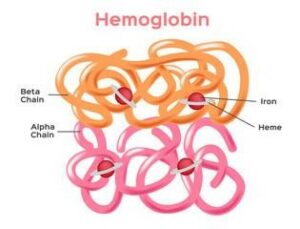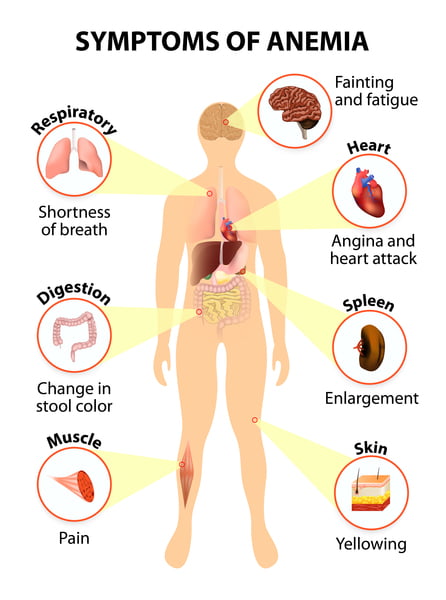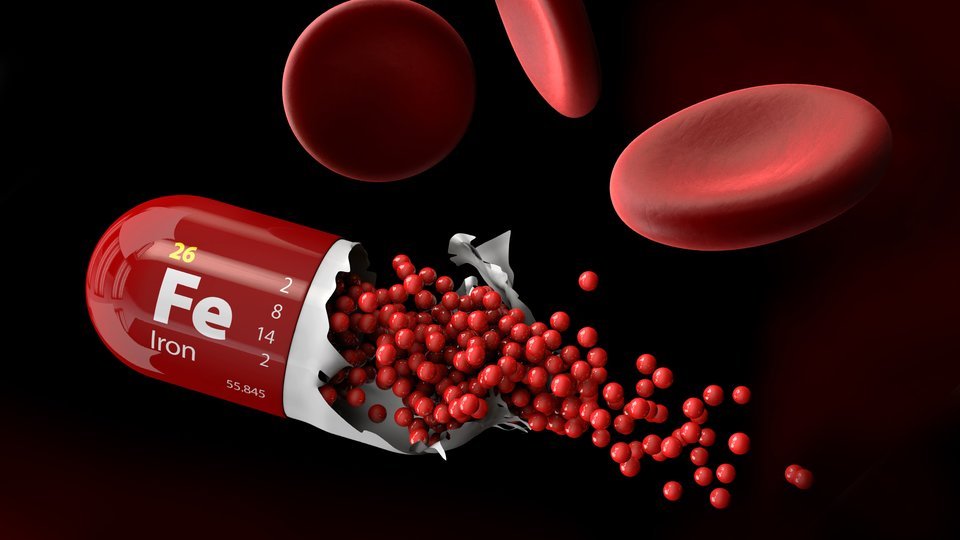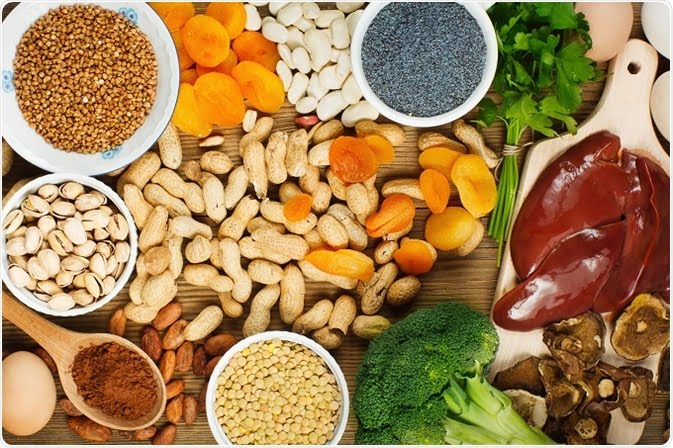Anemia is a condition that is characterized by low levels of hemoglobin in the blood. This can lead to many different symptoms, depending on the kind of anemia you have. In this blog post, we will be going over everything you need to know about anemia. In addition to, how we treat it.
Contents
Anemia

Anemia is a medical condition in which the number of red blood cells or amount of hemoglobin is below normal.
Under this medical condition, there aren’t enough healthy red blood cells (RBCs) or hemoglobin. That carries adequate oxygen throughout your body.
Consequently, people who have this condition feel very tired and weak. Because the RBCs can’t deliver oxygen to their muscles when they need it. Besides, it affects both men and women. However, it’s more common among women due to menstrual cycles.
NOTE: The normal hemoglobin level of a normal male has 12-16 grams/100 ml blood while a female has 11-13 g/100 ml blood.
Hemoglobin And RBCs

We find hemoglobin, an iron compound inside red blood cells. It attaches to oxygen molecules and carries them around the body.
Therefore, people feel less tired when their levels of hemoglobin are high.
In other words, anemia is a medical condition when there aren’t enough RBCs (red blood cells) or they’re low in number.
Types Of Anemia
There are several types of anemia, which vary in their causes. When the cause is not known or it’s due to a disease that isn’t curable, then it’s called ‘anemia’. Learning about anemia and its symptoms will help you identify if there is an issue with your blood cells and take the necessary steps towards recovery. There can be many types of anemia:
Normocytic Anemia
It is caused due to a low number of red blood cells or a low amount of hemoglobin in the body.
Macrocytic Anemia
It is caused due to a lack of vitamin B12 and folic acid. Together, they are essential for the healthy formation of red blood cells. It can lead to neurological complications as well if left untreated.
Normochromic Anemia
It can be caused due to a lack of iron, vitamin B12, or folic acid.
Anemia Of Chronic Disease
This type is associated with infections, diseases like cancer, and autoimmune disorders.
Aplastic Anemia
The bone marrow doesn’t produce enough cells causing severe weakness in the body. It’s mostly seen in children (rare) and young adults. It can also occur due to exposure to radiation, chemotherapy, toxins, or certain drugs.
Bone Marrow Failure
It’s a rare condition and is usually accompanied by blood cancers like leukemia (cancer of the bone marrow).
Iron Deficiency Anemia
This type of anemia is mostly seen in young girls and women who have heavy menstrual periods. A lack of iron causes the body to produce fewer red blood cells. It decreases hemoglobin levels, resulting in fatigue and weakness.
NOTE: In addition to low red blood cell count and iron deficiency anemia, other anemias include thalassemia minor, sickle-cell disease.
Causes Of Anemia
There can be many factors that cause anemia. Some of the factors are listed below:
- Low levels of hemoglobin in the blood (hypochromic),
- Excessive destruction or loss of red blood cells (hemolytic),
- Deficient production within the bone marrow due to various factors (hypo proliferative)
- Bleeding in the gastrointestinal tract (such as peptic ulcers or hemorrhoids),
- Bleeding in the urinary tract (such as kidney stones or bladder infections),
- Heavy menstrual flow
Symptoms Of Anemia

Some common symptoms include:
- Fatigue,
- Paleness,
- Headache,
- Dizziness,
- Grayish Skin Tone,
- Shortness Of Breath
If you are pregnant then there could be other symptoms like:
- Chest Pain,
- Feeling Faint,
- Feeling short of breath during exercise or while climbing stairs,
- Palpitation (sudden fast heartbeats)
You might also feel dizziness and fainting spells when you stand up quickly after sitting or lying down for a long time. Like on an airplane. You might feel the following symptoms:
- Fast heartbeat
- Cold hands and feet
- Difficulty in breathing
Diagnosis And Tests Of Anemia
The diagnosis of iron deficiency anemia is usually made based on symptoms, laboratory tests, and bone marrow examination. For diagnosis, you will need to undergo a few blood test procedures that include:
- Complete Blood Count (CBC),
- Reticulocyte Hemoglobin Content (CHr),
- Mean Corpuscular Volume (MCV),
- Erythrocyte Protoporphyrin (EP), and
- Osmotic Fragility Test
The CBC may be used to detect changes in red blood cells associated with iron deficiency and/or folic acid deficiency anemia.
Reticulocyte hemoglobin content (CHr), Erythrocyte Protoporphyrin, and/or the Osmotic Fragility test may be used to assess iron-deficiency status.
NOTE:
- Degree of iron deficiency is evaluated by iron studies such as serum iron, total iron-binding capacity, and transferrin saturation.
- Special studies are carried out to determine an inherited disorder like thalassemia major.
- It must be noted that the treatment strategy depends on the cause of anemia.
Treatment Options Of Anemia

Treatment will depend on the type of anemia you have. For example, if your anemia is due to surgery or another medical condition. Then doctors should treat this cause first before considering treatment options for your anemia symptoms. Similarly,
Treatment for Normocytic anemia
- Iron supplements or iron injections
- Folic Acid supplement
- Blood transfusion in severe cases
Treatment for Hemolytic Anemia
- Stem cell transplantation (in case of bone marrow failure)
- Chelation therapy to remove excess iron from the bloodstream. We achieve Chelation by taking EDTA, a synthetic amino acid.
- Immunosuppressive therapy to prevent organ damage due to autoimmunity. Immunosuppressive drugs include corticosteroids and cyclophosphamide among others.
- Iron supplements or iron injections in case of anemia associated with chronic hemolysis (RBC breakdown).
Treatment For Macrocytic Anemia
- Folic Acid supplements
- Iron supplement or iron injections
Treatment For Megaloblastic Anemia
- B12 and folic acid (folate) supplementation to replace the low B12 and folates in your body, usually due to a lack of intake during diet
- Vitamin D Supplementation and exposure to sunlight (for people with dietary or malabsorption causes)
- Oral Iron Supplementation
Treatment For Normochromic Anemia
- Iron supplement or iron injections
Treatment for Pernicious Anemia
- Vitamin B12 (Cobalamin) supplements to replace low levels of vitamin B12 in the body, usually due to dietary intake deficiency
- Oral Iron Supplementation
NOTE: The treatment for aplastic anemia will depend on the cause of your condition. This can range from removing any environmental toxins, medications that you might be taking, etc. You should consult a doctor who specializes in treating such conditions.
Food Sources Rich In Iron

Maintaining a healthy diet is important. For example, doctors recommend that people with anemia eat more foods rich in iron. The following are the food sources rich in iron:
Dried Beans And Lentils
These foods contain iron. But they don’t have vitamin C which helps you absorb more of it. Try to eat them with citrus fruit or tomato sauce. In addition, you can also add a little meat since these foods are usually low in protein.
Dark green vegetables
Kale and broccoli contain iron. But they also have vitamin C which helps you absorb it better. Try to steam these veggies instead of boiling them. As it will not destroy vitamins by heat exposure.
Eggs
Eggs are high in protein. So they can help you absorb more of the iron from other foods too. Try to eat hard-boiled eggs. Because cooking them less may reduce the amount of iron available for absorption as well.
Iron-fortified cereals and bread
They may help you meet your daily requirement for this nutrient. These products contain a pretty small amount of iron as compared to other sources like meats or beans.
Iron-fortified pasta
It is good for those who don’t eat meat or aren’t able to find iron-rich foods with vitamin C. The amount of iron they contain will help you meet your daily requirement. But it may not be as much as if you were eating food with higher levels like lentils or beans.
Fruits And Veggies
They have a little bit of iron but it’s not much. They also don’t contain vitamin C which helps you absorb more. So they won’t help boost your levels as well as other sources do.
Iron-fortified Bread And Cereals
They may help you meet your daily requirement. As they contain a pretty low amount of iron compared to other sources like meat or beans.
White Bread
It is plant-based and has a little bit of iron. You can get more iron from eggs or meat. Because they contain much higher levels of iron.
Conclusion
We can treat many causes of anemia with different types of treatments. You should opt for a diagnosis or test if you think you have this condition. As the medical professionals can accurately diagnose the cause and give appropriate treatment.
Do you want to get rid of diabetes? Join our online diabetes consultation program and reverse your Diabetes naturally through lifestyle changes such as a Personalized Diet plan, Exercise, dieticians, and health coaches.


